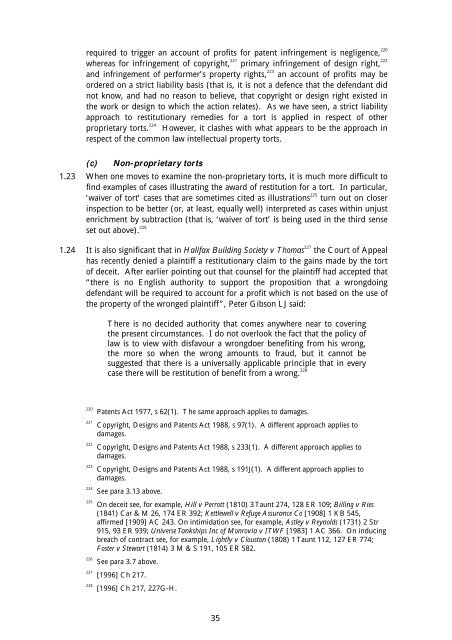Aggravated, Exemplary and Restitutionary ... - Law Commission
Aggravated, Exemplary and Restitutionary ... - Law Commission
Aggravated, Exemplary and Restitutionary ... - Law Commission
Create successful ePaper yourself
Turn your PDF publications into a flip-book with our unique Google optimized e-Paper software.
equired to trigger an account of profits for patent infringement is negligence, 220<br />
whereas for infringement of copyright, 221<br />
primary infringement of design right, 222<br />
<strong>and</strong> infringement of performer’s property rights, 223<br />
an account of profits may be<br />
ordered on a strict liability basis (that is, it is not a defence that the defendant did<br />
not know, <strong>and</strong> had no reason to believe, that copyright or design right existed in<br />
the work or design to which the action relates). As we have seen, a strict liability<br />
approach to restitutionary remedies for a tort is applied in respect of other<br />
proprietary torts. 224<br />
However, it clashes with what appears to be the approach in<br />
respect of the common law intellectual property torts.<br />
(c) Non-proprietary torts<br />
1.23 When one moves to examine the non-proprietary torts, it is much more difficult to<br />
find examples of cases illustrating the award of restitution for a tort. In particular,<br />
‘waiver of tort’ cases that are sometimes cited as illustrations 225<br />
turn out on closer<br />
inspection to be better (or, at least, equally well) interpreted as cases within unjust<br />
enrichment by subtraction (that is, ‘waiver of tort’ is being used in the third sense<br />
set out above). 226<br />
1.24 It is also significant that in Halifax Building Society v Thomas 227<br />
the Court of Appeal<br />
has recently denied a plaintiff a restitutionary claim to the gains made by the tort<br />
of deceit. After earlier pointing out that counsel for the plaintiff had accepted that<br />
“there is no English authority to support the proposition that a wrongdoing<br />
defendant will be required to account for a profit which is not based on the use of<br />
the property of the wronged plaintiff”, Peter Gibson LJ said:<br />
There is no decided authority that comes anywhere near to covering<br />
the present circumstances. I do not overlook the fact that the policy of<br />
law is to view with disfavour a wrongdoer benefiting from his wrong,<br />
the more so when the wrong amounts to fraud, but it cannot be<br />
suggested that there is a universally applicable principle that in every<br />
case there will be restitution of benefit from a wrong. 228<br />
220 Patents Act 1977, s 62(1). The same approach applies to damages.<br />
221 Copyright, Designs <strong>and</strong> Patents Act 1988, s 97(1). A different approach applies to<br />
damages.<br />
222 Copyright, Designs <strong>and</strong> Patents Act 1988, s 233(1). A different approach applies to<br />
damages.<br />
223 Copyright, Designs <strong>and</strong> Patents Act 1988, s 191J(1). A different approach applies to<br />
damages.<br />
224 See para 3.13 above.<br />
225 On deceit see, for example, Hill v Perrott (1810) 3 Taunt 274, 128 ER 109; Billing v Ries<br />
(1841) Car & M 26, 174 ER 392; Kettlewell v Refuge Assurance Co [1908] 1 KB 545,<br />
affirmed [1909] AC 243. On intimidation see, for example, Astley v Reynolds (1731) 2 Str<br />
915, 93 ER 939; Universe Tankships Inc of Monrovia v ITWF [1983] 1 AC 366. On inducing<br />
breach of contract see, for example, Lightly v Clouston (1808) 1 Taunt 112, 127 ER 774;<br />
Foster v Stewart (1814) 3 M & S 191, 105 ER 582.<br />
226 See para 3.7 above.<br />
227 [1996] Ch 217.<br />
228 [1996] Ch 217, 227G-H.<br />
35
















